
Table of contents:
- Neva Masquerade - a cat that gathered for the carnival
- How the Neva Masquerade Cat appeared
- The appearance of the Neva Masquerade
- The nature and behavior of the Neva Masquerade
- Health of the Neva Masquerade Cat
- How to buy a kitten of the Neva Masquerade cat
- Care and feeding issues
- Breeding and castration of Neva Masquerade cats
- Owner reviews of the breed
- Author Bailey Albertson [email protected].
- Public 2024-01-17 22:26.
- Last modified 2025-06-01 07:32.
Neva Masquerade - a cat that gathered for the carnival
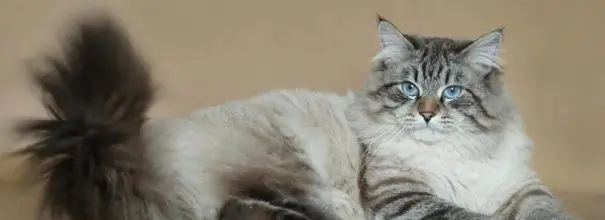
The Neva Masquerade cat is a variety of the Siberian breed, distinguished by its colorpoint color. This adorable and affectionate animal falls in love at first sight with both experienced "cat lovers" and those who have decided to have a pet for the first time.
Content
-
1 How the Neva Masquerade Cat appeared
1.1 Video: Neva Masquerade Cat
-
2 The appearance of the Neva Masquerade
-
2.1 Variety of colors
2.1.1 Photo gallery: types of colors of the Neva Masquerade cat
-
-
3 The nature and behavior of the Neva Masquerade
3.1 Video: all about cats: Neva Masquerade
- 4 Health of the Neva Masquerade cat
- 5 How to buy a kitten of the Neva Masquerade cat
-
6 Care and feeding issues
- 6.1 Feeding the Neva Masquerade
- 6.2 Video: Neva Masquerade Cat: Care and Maintenance
- 7 Breeding and castration of Neva Masquerade cats
- 8 Owner reviews of the breed
How the Neva Masquerade Cat appeared
Scientists are still arguing about the origin of the breed. On the one hand, Siberian cats became the ancestors of such marvelous purrs. On the other hand, it is not clear whether there were "blood infusions" of other breeds (in particular, the Himalayan and Siamese). After all, colorpoint color is not typical for Siberian cats.
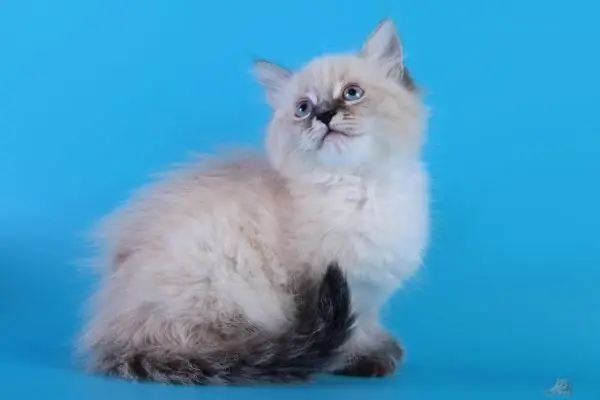
Neva Masquerade cats are direct descendants of Siberian purrs
The first time a Siberian cat with spotted body parts was presented at an exhibition in Leningrad in 1988. Then it was decided to continue work on consolidating the revealed color features. In addition, felinologists have singled out the new individual into a separate group, calling the purr the Neva Masquerade cat. After all, the dark areas on the face of this fluffy resembled a mask in which the nobles of the time of Peter the Great came to balls.
The solution to this problem was undertaken by the St. Petersburg group of felinologists from the Kotofey club led by Olga Mironova. As the breed became popular with adorable cats, Moscow breeders also became interested. Moreover, the professionals were engaged in breeding independently of each other, due to which the spotted descendants of Siberians began to spread widely throughout the country.
The breed has not yet received official recognition in all felinological organizations. And even among breeders there is no consensus on whether their colorpoint murders belong to a new variety or not.
In 1992, the Neva Masquerade cat was registered by the World Cat Federation (WCF), and in 2008 the standard was approved by the International Cat Federation (FIFE) in Slovakia, with the beginning of its operation on January 1, 2009
Currently, the breed of Neva cats is in great demand not only at home, but also far beyond its borders - in Europe and many states of America.
Video: Neva Masquerade Cat
The appearance of the Neva Masquerade
The striking appearance of these fluffy purrs is made up of several components - a thick coat with a dense double undercoat and unusual blue eyes.
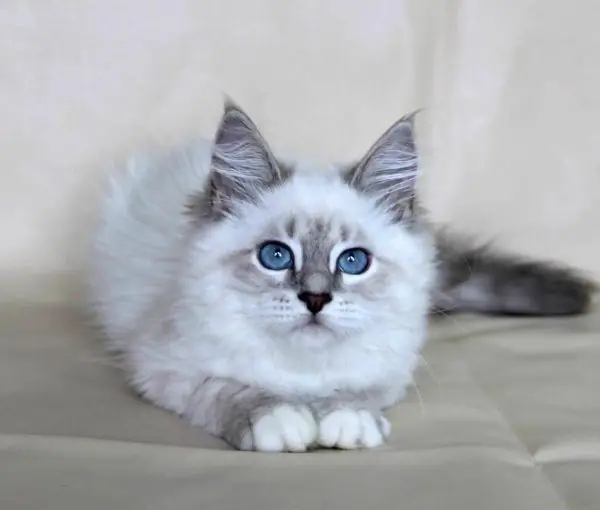
Neva masquerade cats are remembered for their bright appearance
In addition, the elegant purrs have very powerful legs combined with a strong, muscular torso. The body ends with a long, wide tail with an abundant edge. The proportions of the body are such that they form a regular rectangle.
Other characteristic features of the appearance of the Neva Masquerade cat are:
- proportional trapezoidal head;
- nose with smooth outlines, turning into a wide forehead;
- dense cheeks, between which there is a massive chin;
- medium sized ears, slightly tilted forward;
- rounded ear tips with small tassels;
- set wide apart, large slanted eyes;
- the presence of "collar" and "pants" in the composition of the fur coat.
As for the dimensions of such long-haired seals, the pussies are only slightly inferior here to the Maine Coons. The weight of an adult male reaches 8-9 kg, and females weigh an average of 6 kg. Height at the withers ranges from 25 to 40 cm.
The disadvantages of the breed, which do not allow to take prizes at exhibitions, include:
- small size;
- too straightened profile;
- elongated muzzle;
- small, closely spaced eyes;
- weakened chin;
- too big or small ears;
- thin fragile paws;
- tail with a weak edge;
- hair unevenly distributed over the body without undercoat.
Variety of colors
Separately, it is worth touching on the color of the Neva Masquerade cats. Despite the fact that these descendants of Siberian purrs may have only a spotted colorpoint coloration, there have been many variations in the shades of the latter over two decades.
So, felinologists distinguish the following types of Siamese color from "Nevaks":
- seal point - when the body is painted in a cream tone, and the limbs have a color from deep gray to black;
- blue-point - blue-white hair on the body echoes the gray-blue or intense gray with a blue tint on the paws, ears, muzzle and tail;
- red point - in this case, the body is painted in pinkish-cream shades, and the spots are highlighted with a red tint (the rarest color);
- tortie point (tortoiseshell) - a cream coat is bordered by spots on the limbs, which have a darkened cream or deep red color (typical only for females of the breed);
- cream point - very dark cream spots are located on a cream-colored fur coat (often combined with tabby);
- choklite point (chocolate) - in this case, the hair on the body is ivory colored, and the limbs have a pile of soft chocolate undertone;
- tabby point - denotes a type of spot shape, when the color does not occur entirely, but in the form of stripes.
In order for the color to correspond to the breed standard, you need an even distribution of color in each area, be it the tail or muzzle, paws or ears.
Photo gallery: types of colors of the Neva Masquerade cat
-

Chocolate colored Nevsky cat reclining with one paw outstretched - Chocolate color gives the Neva Masquerade cats mystery and charm
-

Cream-point nevak sits with one leg raised - Delicate cream coloring of the Nevsky cat will not leave anyone indifferent
-

A kitten of the Neva Masquerade Blue Point lies with its front legs crossed - Blue-point - an unusual and noble type of coat shade in Nevaks
-

Nevskaya masquerade red-point color lies on a blue background - Red-point is the rarest color in Neva Masquerade cats
-

Nevsky cat seal point sits on an orange sofa - Seal point is the most common color among Nevaks.
-

Nevsky masquerade cat with tabby point sits looking sideways - With a variety of tabby color, stripes are visible on the face and paws
-

Cat of the Neva Masquerade breed with a tortie point color - Cake point is typical only for females of the Neva Masquerade breed
It is noteworthy that the color of such pussies belongs to the temperature-dependent category. Neva Masquerade cats are albinos, in which the color is formed over time (up to one year). And by how hot this or that part of the body will be, one can judge the intensity of the color on the face, ears, tail and paws.
The nature and behavior of the Neva Masquerade
Despite the brutal appearance, the Neva masquerade cats have a very gentle and devoted disposition. At the same time, the purrs of this intelligent breed do not tolerate excessive caresses and are dissatisfied with the desire to "cuddle" them.
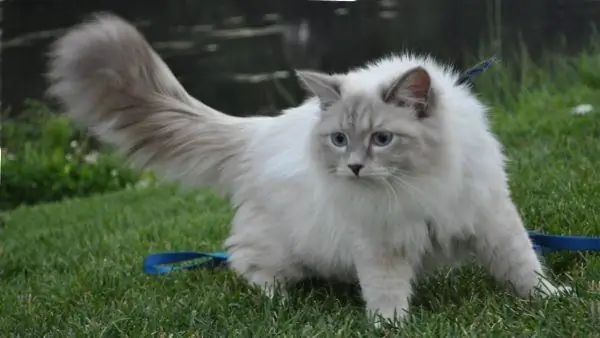
Neva Masquerade - gentle creatures with a freedom-loving disposition
Such pets are distinguished by a high level of intelligence and will never impose their society on the owner. Fidelity in the look and the ability to predict the mood of each household - these are the distinctive character traits of the fluffy "Nevaks".
Other benefits of the breed include:
- quick response to the nickname, rather than the classic "kitty-kitty";
- easy adaptation to a change of environment;
- curiosity and curiosity;
- choice as the owner of one of the family members;
- playfulness and mobility in childhood;
- understanding intonations in communication with an animal and quick response to commands;
- not vindictiveness, expressed in the absence of a manner of nasty in the case of an undeserved resentment.
In addition, the physiological characteristics of the Neva purrs are also worthy of praise. The fact is that in the saliva of these animals there is no substance FEL D1 (protein protein), which can cause an allergic reaction. Therefore, the fur of the fluffy does not pose a threat to people with increased sensitivity of receptors.
At the same time, an elegant fur coat sometimes causes inconvenience to the owners - twice a year, the Neva Masquerades have a molt. However, with careful grooming and regular combing, the animal's fur will be scattered around the house.
In addition, the breed's disadvantage is the excessive talkativeness of certain representatives. Cats love not only to purr, but also to meow loudly, telling the owner unknown stories.
Purrs behave friendly with other household members, and especially with children. Kittens, even if they play hard, never release their claws. But the Nevaks have a wary and proud attitude towards strangers and guests. In rare cases, the cat will allow a stranger who comes into the house to take himself in his arms. Trust must be earned.
Other pets will become good friends for the Neva Masquerade cat, be it dogs or birds, rodents or turtles.
Video: all about cats: Neva Masquerade
youtube.com/watch?v=ZsbsNctqWJw
Health of the Neva Masquerade Cat
Since the ancestors of pedigree purrs were Siberian cats, which are distinguished by enviable immunity, then blue-eyed descendants practically do not have health problems. After all, selection took place naturally, and genetic diseases were thus excluded from the list of possible diseases.
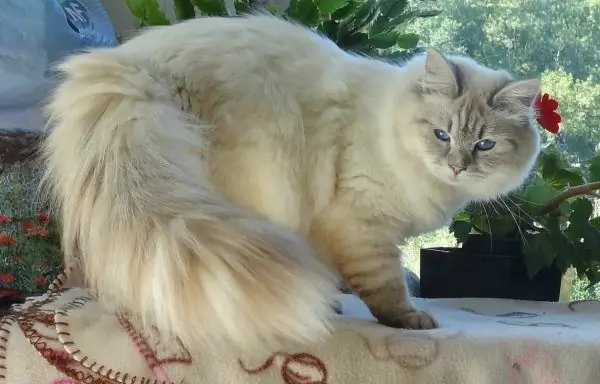
Nature has endowed the Neva Masquerade cats with remarkable health
The only danger to pussies is a disease that is inherent in many other representatives of the feline family. The disease is called hypertrophic cardiomyopathy and is a malformation of the circulatory system, in which blood stagnates in the pulmonary vessels. The extreme form is pulmonary edema, leading to death.
The danger of the disease lies in the asymptomatic course, therefore it is important to regularly examine the animal at the veterinarian
In addition, disease prevention includes systematic helmentization, as well as protection against the appearance of fleas and ticks.
With careful and attentive care, the Neva Masquerade cat will live a long and interesting life - at least 15-18 years. Long-livers aged 20 and more are also found in the breed.
An important role in improving the quality of life of a pet is played by regular vaccinations, which are carried out according to the following schedule:
- The first comprehensive vaccination at 9-12 weeks (protection against plague, calcivirosis, chlamydia, rhinotracheitis).
- Revaccination together with rabies vaccination, one month after the first injection of the drug.
- Vaccination after the animal is one year old.
- Annual vaccination with a complex vaccine.
In addition, if the cat goes outside, it is recommended to give the pet a lichen vaccine.
And also the cat should always be protected from colds and indigestion. In the latter case, it is better to use special pastes that cleanse the digestive organs from lumps of swallowed wool.
How to buy a kitten of the Neva Masquerade cat
Since the breed is considered primordially Russian, it is not difficult to acquire a small fluffy on the territory of our country.
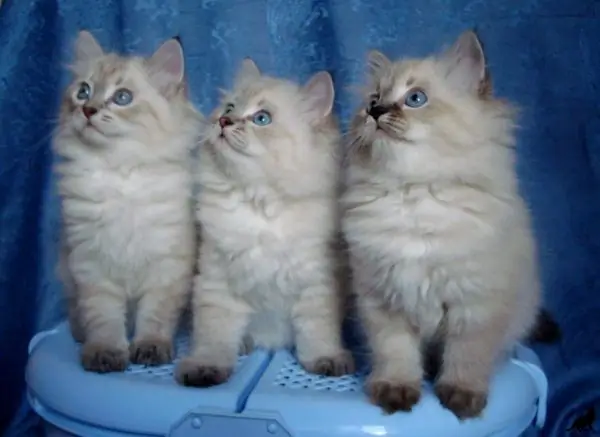
Neva masquerade kittens - cute fluffy lumps
The price of a pet depends on the gender of the baby and the class of the breed. Pet females (intended for home maintenance) are the cheapest - from 8 thousand rubles. But males of the breed and show class will cost 20 thousand rubles. and more.
Affects the cost of the animal and the place of purchase. So, from "good hands" according to the ad you can get an inexpensive pet (from 2 thousand rubles), but such a purr will most likely not have a pedigree and the necessary vaccinations. Which is fraught with unpredictable behavior of the fluffy or genetic diseases (after all, nothing will be known about the cat's parents).
It is best to make a choice in favor of a specialized nursery, of which there are enough created in large cities. So, the organizations "Nevsky Modern", "The Pearl of the Neva" and "Beloved Beauty" are engaged in Moscow Nevaks, in the homeland the purr is bred in "Nevskaya Krasa" and "From the banks of the Neva". In Yekaterinburg, cats of the Neva Masquerade breed can be purchased at the Pchelka and Neva Magic catteries, and in Vladivostok, elegant pussies are bred in Ussuri.
Breeders do not recommend purchasing a toilet and pet food in advance, because individual recommendations will be received only after choosing a specific individual.
It is better to contact the nursery for a kitten that is already 12 weeks old. Before this period, the baby will be very painful to experience separation from his mother - it is bad to eat, constantly screaming, “crying”.
To make the right choice from the presented pedigree cats, you need to pay attention to the following points:
- lack of lilac and chocolate shades on the fur coat (breed marriage);
- even distribution of pigment in dark areas of the body;
- the muzzle, paws, tail and ears should be darkened;
- strong bones, wide chest, short neck - regardless of gender;
- wide-set, open eyes (they will not be blue at once, the color is set closer to the year, but fixed by two years);
- there should be tufts of wool between the fingertips;
- the ears are rounded at the tips and are located at an angle to the head;
- there is a collar around the neck, and the main coat is provided with a thick undercoat.
If the question arises of which one is better to choose - a kitty or a cat, then the latter will be more proud and independent. And the females of the breed are distinguished by strong devotion and affection.
Care and feeding issues
Owners of any domestic cat should be mindful of regular pet hygiene. Neva masquerade purrs will not be an exception.
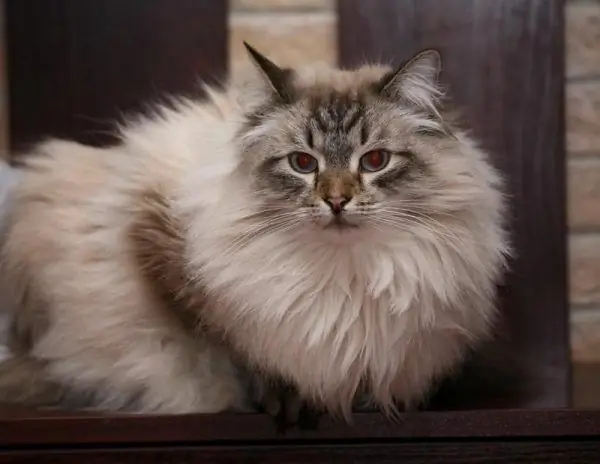
Neva Masquerade cats are not demanding in grooming
The long and thick fur of the animal requires most attention. The owner should prudently stock up on a slicker, a metal-toothed massage brush and special shampoos for long-haired pedigree cats.
The cat should be combed every two days, and during molting (in spring and autumn) - every day.
Bathing of the Neva purrs is of great importance during the period of changing the coat - it is better to carry out the procedure once every 3-4 days. Then the house will not be filled with particles of a falling fur coat. The rest of the time, the cat can take a bath no more than once every two to three weeks.
In addition, the hygiene of the Neva Masquerade cat includes regular cleaning of the ears and teeth (once or twice a month), washing the eyes (daily), and trimming the claws (as the nail plates grow)
The eyes are washed with a cotton pad dipped in warm boiled water. And the ears are cleaned with cotton swabs coated with a special remedy for ear parasites. Or, in the absence of such, use a little vegetable oil. Cat pastes and brushes are used to remove plaque from teeth and prevent tartar. Or just more often they give to gnaw on hard cartilage or bones.
It is strictly forbidden to cut the wool of nevakam. Since this procedure changes the structure of the hair, because of which the color is irreversibly deteriorated and becomes completely dark.
As for the choice of the toilet, here you need to consider several features - the large size of the animal and the length of the coat. Therefore, it is better to take a wide tray, and the filler in large granules.
You need to train a kitten to the toilet immediately after arriving from the cattery. To speed up the process, you can use special flavored products that are placed in the tray. Nevaki are distinguished by a sharp mind, so it is enough to put a fluffy in a container two or three times to send needs.
It is recommended to choose a place for a toilet that is secluded, away from the front door and drafts.
Feeding the Neva Masquerade
Separately, it is worth considering the nutritional issues of thoroughbred fluffy animals. Indeed, the health of the pet depends on the correctly selected food and the correctly developed feeding regime.
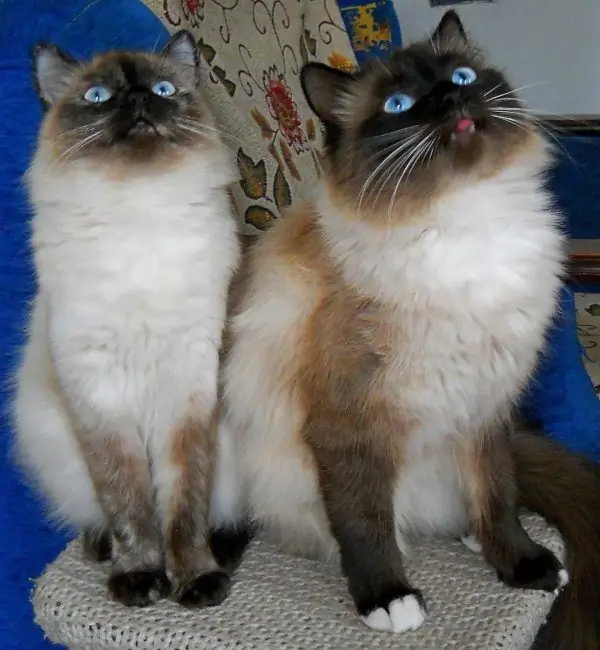
You can feed the Neva cat with both natural food and special food
It should be remembered that such large animals do not suffer from obesity. Therefore, you can safely include meat and offal (beef, rabbit, poultry) in the menu. Raw and stewed vegetables, cereal dishes and dairy products (kefir, yogurt, cottage cheese) will help to diversify food. But it is better not to give fish and liver to the purr, because the pigments included in such food do not affect the color of the coat for the better.
A portion of each dish for an adult cat should be 120 grams. The kitten should be given at least 160 grams of food per day and no more than 200 grams.
An adult pet should be fed twice a day, and kittens should be fed depending on age (two months old - 7 times a day, four months old - five, and from 9 to 12 months, four times are enough).
If it is customary to give the cat natural food, then you should not forget about vitamin complexes with calcium and phosphorus to maintain the beauty of the coat and the strength of the bones.
And when the pet is fed with ready-made food (preferably premium or super-premium class), it is important to monitor the availability of clean drinking water for the animal
It is important to remember that you cannot mix feed types. Nevak is fed with either simple food or only specialized food.
Smoked, sweet and flour dishes, bread, salty and fried foods are strictly prohibited for pussies.
Video: Neva Masquerade cat: care and maintenance
Breeding and castration of Neva Masquerade cats
The breed standard prohibits crossbreeding of these intelligent women with representatives of other breeds. Following this immutable rule, you can breed Nevaks without any problems. After all, unrelated future "moms" and "dads" can be found in every major city.
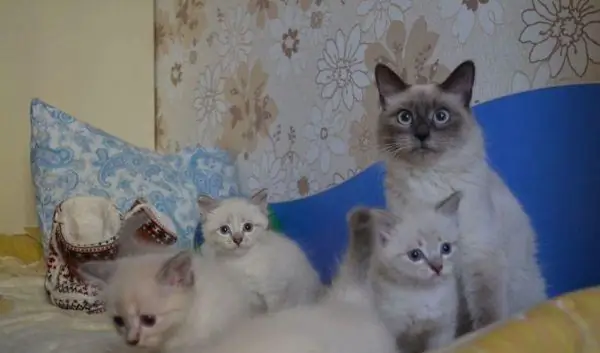
Breeding Neva Masquerades is not particularly difficult
Puberty in Neva seals begins at the age of 9 months, and in cats - at 8 months. In order for the pet to safely go through the unleashing process, it is better to give the animals for the first mating after three past heats.
Since the Neva Masquerades are in good health, the pregnancy usually passes without complications and lasts 64-72 days. The cat tolerates childbirth easily at home, so the help of a veterinarian is not required.
If the owner makes a decision to castrate (or sterilize, that is, ligation of the genital canals) of the animal, then the following should be considered:
- it is better to carry out the operation in adolescence, before the first estrus (which is 6-7 months of age);
- before going to the clinic, the pet should be proglisted and get rid of ectoparasites (fleas, ticks);
- two hours before the operation, stop feeding the pet;
- on the first day after the intervention, feed the cat often and in small portions;
- while the purr is moving away from anesthesia during the day, monitor the movement of the cat and prevent falls;
- often offer the animal clean drinking water the first day after the removal of the glands or bandaging the cords.
After castration, the Neva Masquerade cat is transferred to a special diet in order to avoid obesity. The same rule applies to sterilized cats.
Owner reviews of the breed
Neva Masquerade cats are always popular due to their wide availability and attractive appearance. And the nature and habits of these intelligent animals make people write flattering reviews on the Web.
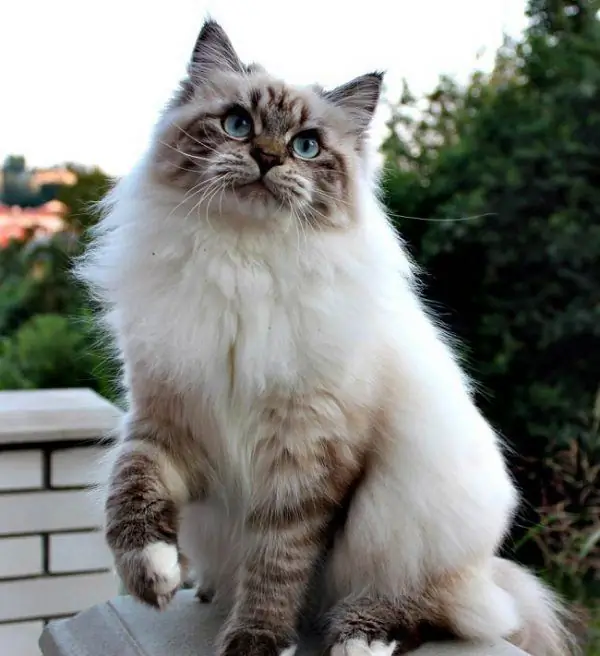
Neva Masquerade cats are the favorites of the public
According to the author, the Neva Masquerade cats will become wonderful pets for both busy people and families with children. After all, Nevaki are famous for their independent character and do not like excessive attention to their own person. Unpretentious and not requiring special care (in addition to regular brushing), animals will decorate the hearth with their presence, making it cozy and "warm". You will want to return to the house where the Neva cat with a piercing blue gaze lives.
The breed of Neva Masquerade cats is distinguished by its noble color and sky-blue eyes. If you like the Siamese color, but at the same time want to have a fluffy and corpulent cat, Nevaki will be an excellent choice for pet lovers.
Recommended:
Bengal Cat: Description Of The Breed, Character And Habits, Photos, How To Choose A Kitten, Reviews Of The Owners Of A Home Bengal
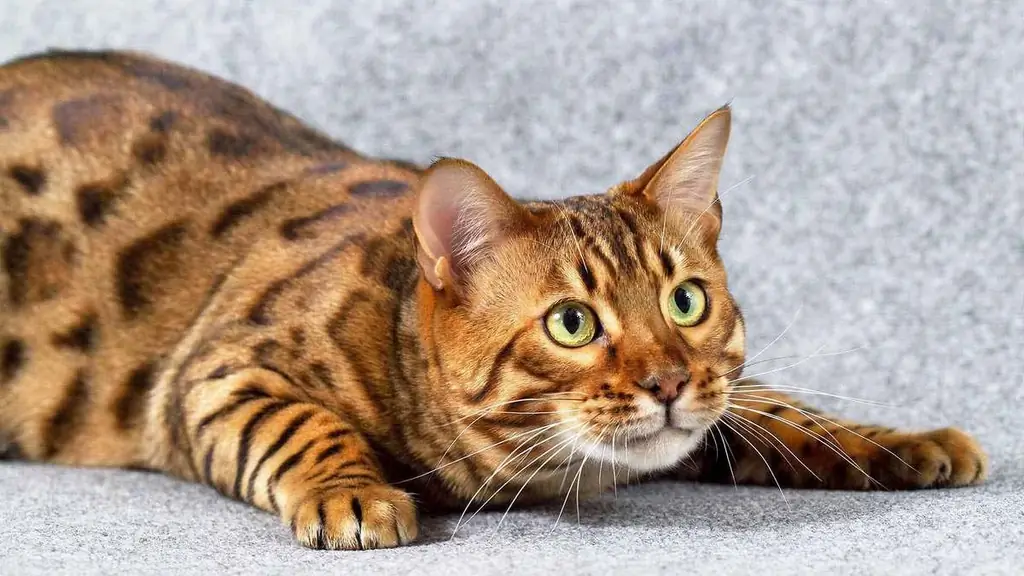
The origin of Bengal cats. External description of the breed. Features of the acquisition. The character and behavior of Bengals. The specifics of caring for a Bengal cat. Reviews
Kurilian Bobtail: Photo, Description Of The Breed, Character And Behavior Of The Cat, Reviews Of The Owners Of The Cat, The Choice Of A Kitten
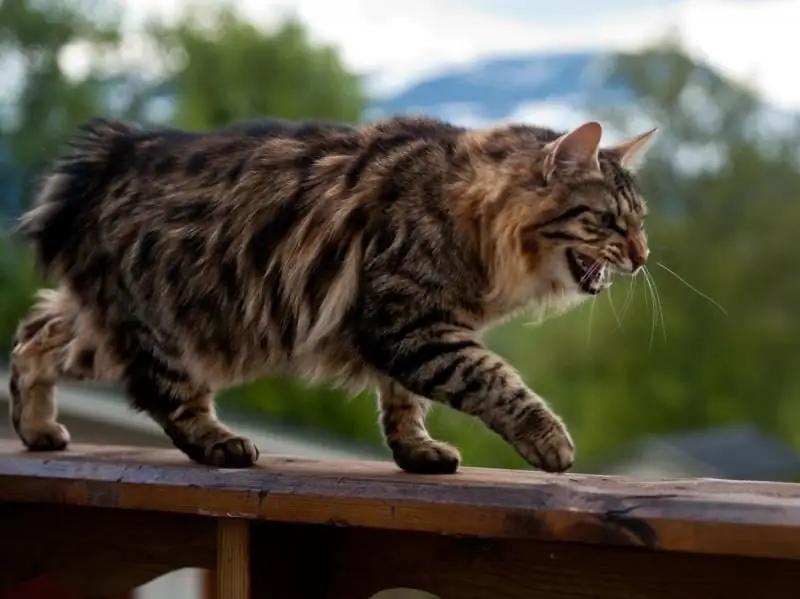
The history of the Kurilian bobtail. Description of the breed. The nature and behavior of Kuril cats. Diseases of the breed. Buying a kitten breed. Care and hygiene. Breeding. Reviews
Siamese Cat: Description Of The Breed, Character And Habits, Owner Reviews, Photos, Kitten Selection, Difference From Thai Cats
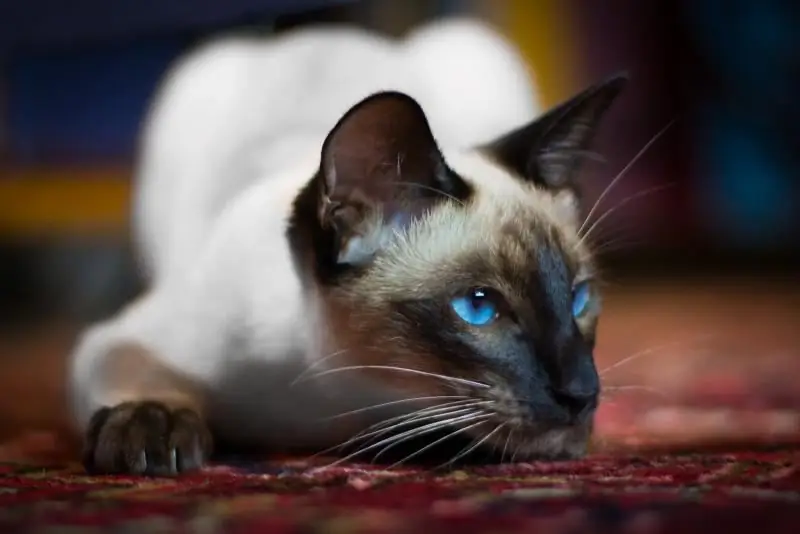
Everything you need to know about the Siamese cat: the history of the breed, how Siamese cats differ from Thai cats, how to care for them, how to choose purebred kittens
Chausie: Description Of The Breed, Character And Habits Of A Houseie Cat, Photo, Choice Of A Kitten, Reviews Of Cat Owners
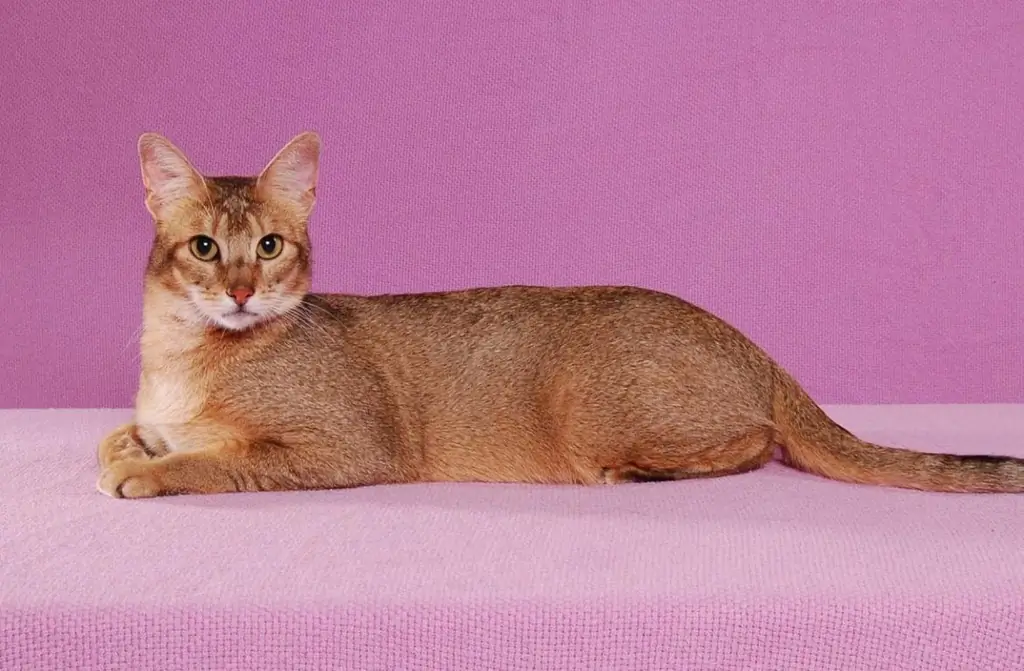
The history of the origin of Chausie. Breed standard. Character, behavior, health. Features of nutrition. Tips for choosing a Chausie kitten. How to breed. Reviews. Video
Turkish Van: Photo Of A Cat, Description Of The Breed, Character And Habits, Owner Reviews, Choice Of A Van Kitten
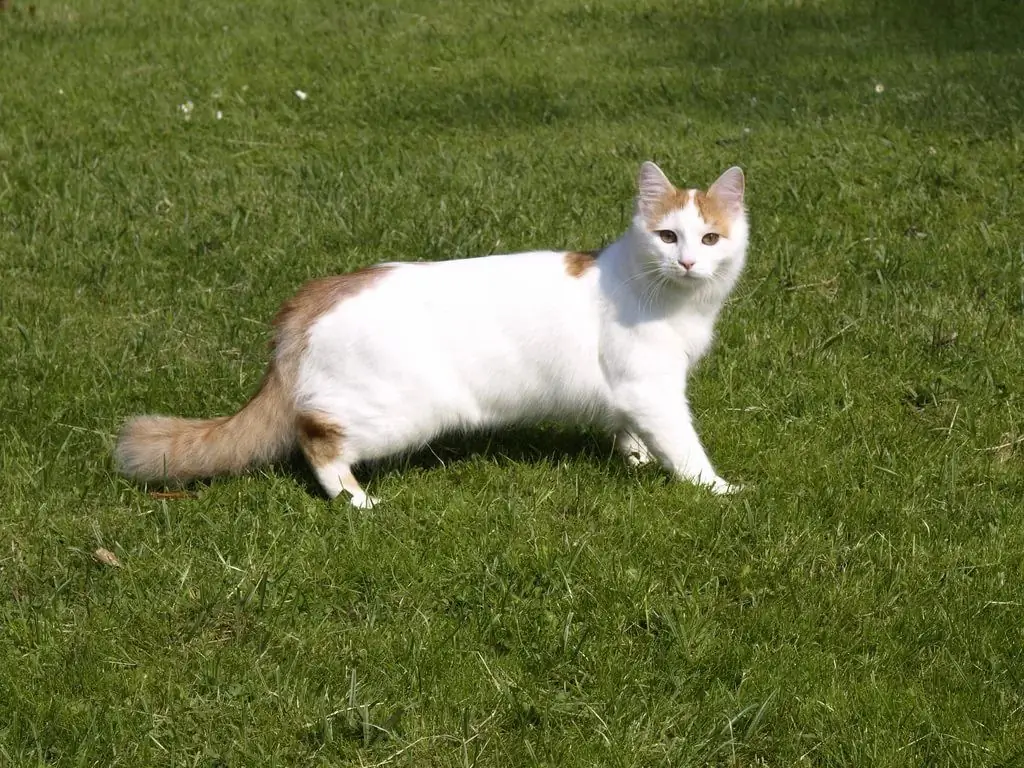
Where did the Turkish Van breed appear, what are the main external differences and character. How to properly care for the breed, how to choose a kitten. Host Reviews
